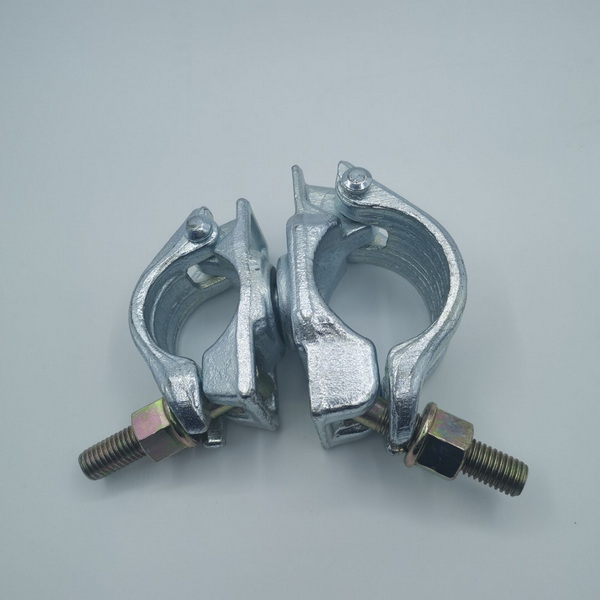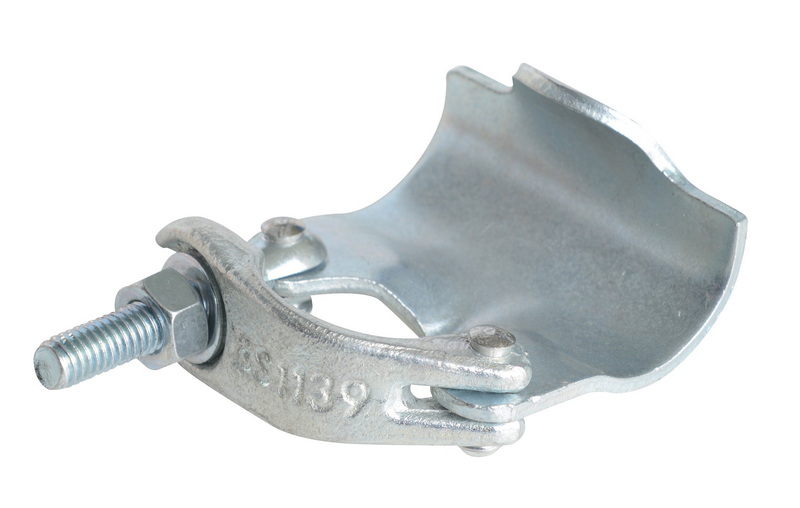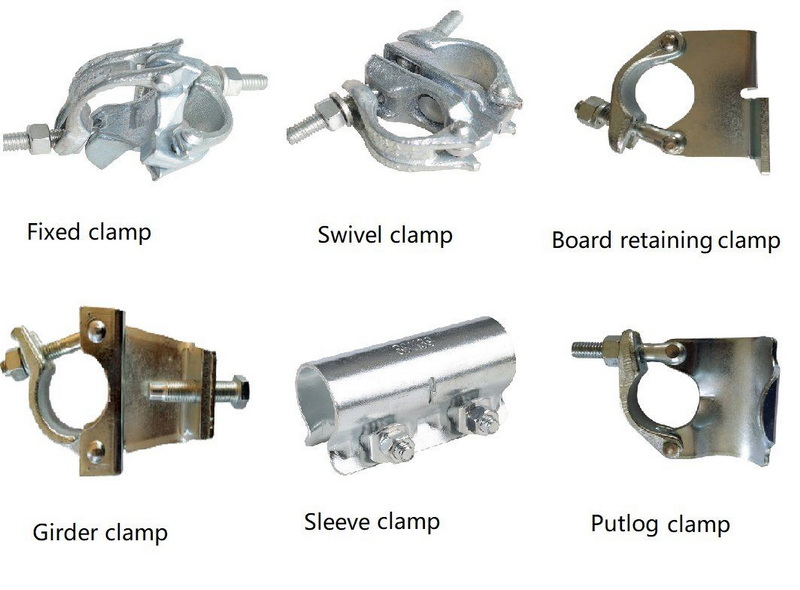Content Menu
● Types of Coupler Scaffolding Clamps
>> 1. Double Coupler (Right Angle Clamp)
>> 2. Swivel Coupler
>> 3. Putlog Coupler
>> 4. Sleeve Coupler
>> 5. Girder Coupler
>> 6. Board Retaining Coupler (BRC)
● Factors to Consider When Choosing Coupler Scaffolding Clamps
● Proper Installation and Maintenance of Coupler Scaffolding Clamps
● Innovations in Coupler Scaffolding Clamp Design
>> Quick-Lock Couplers
>> Smart Couplers
● Safety Considerations for Coupler Scaffolding Clamps
● Environmental Impact and Sustainability
● Conclusion
● FAQ
>> 1. What is the difference between a double coupler and a swivel coupler?
>> 2. How often should coupler scaffolding clamps be inspected?
>> 3. Can coupler scaffolding clamps from different manufacturers be used together?
>> 4. What is the typical load capacity of a standard coupler scaffolding clamp?
>> 5. Are there any alternatives to traditional metal coupler scaffolding clamps?
● Citations:
Scaffolding is an essential component in construction and maintenance projects, providing temporary structures for workers to access elevated areas safely. At the heart of these structures are coupler scaffolding clamps, which play a crucial role in connecting and securing various components of the scaffolding system. This article will explore the different types of coupler scaffolding clamps, their functions, and their importance in ensuring the stability and safety of scaffolding structures.

Types of Coupler Scaffolding Clamps
1. Double Coupler (Right Angle Clamp)
The double coupler, also known as the right angle clamp, is one of the most common types of coupler scaffolding clamps. It is designed to connect two scaffold tubes at a 90-degree angle[1]. This type of clamp is essential for creating the basic framework of a scaffolding structure.
- Typically made of forged steel for durability
- Can support heavy loads
- Available in various sizes to fit different tube diameters
- Often galvanized for corrosion resistance
2. Swivel Coupler
Swivel couplers are versatile clamps that allow for the connection of two scaffold tubes at any angle[3]. This flexibility makes them invaluable for creating complex scaffolding structures or adapting to irregular building shapes.
- Adjustable angle connections
- Ideal for curved or non-standard structures
- Enables the creation of bracing and diagonal supports
3. Putlog Coupler
Putlog couplers, also known as single couplers, are designed to connect a single tube to another at a right angle[1]. They are commonly used to attach transoms (horizontal tubes) to ledgers (vertical tubes) in a scaffolding structure.
- Securing scaffold boards
- Creating platform supports
- Attaching guardrails and toe boards
4. Sleeve Coupler
Sleeve couplers, also called joint pin couplers, are used to join two scaffold tubes end-to-end[1]. They provide a secure connection that maintains the strength and stability of the scaffolding structure.
- Allows for the extension of scaffold tubes
- Ensures a strong and aligned connection
- Often used in tall scaffolding structures
5. Girder Coupler
Girder couplers are specialized clamps designed to attach scaffold tubes to steel beams or other structural elements[1]. They are essential for securing scaffolding to existing structures or creating cantilever platforms.
- Attaching scaffolding to building facades
- Creating suspended platforms
- Securing scaffolding in industrial settings
6. Board Retaining Coupler (BRC)
Board retaining couplers are used to secure scaffold boards to the scaffolding structure[1]. They help prevent boards from lifting or shifting, enhancing the safety of the working platform.
- Improves platform stability
- Reduces the risk of falling objects
- Enhances overall scaffolding safety

Factors to Consider When Choosing Coupler Scaffolding Clamps
When selecting coupler scaffolding clamps for a project, several factors should be taken into account:
1. Load capacity: Ensure the clamps can support the expected weight and stress of the scaffolding structure.
2. Compatibility: Choose clamps that are compatible with the scaffold tube sizes and materials used in your project.
3. Compliance with standards: Select clamps that meet relevant safety standards and regulations, such as EN 74-1:2005, BS 1139-2.2:2009, or ANSI/SSFI SC100-5/05[5].
4. Material and finish: Consider the environmental conditions and choose clamps with appropriate corrosion resistance, such as galvanized or powder-coated finishes.
5. Ease of use: Opt for clamps that are easy to install and adjust, especially for projects requiring frequent assembly and disassembly.
Proper Installation and Maintenance of Coupler Scaffolding Clamps
To ensure the safety and longevity of scaffolding structures, proper installation and maintenance of coupler scaffolding clamps are crucial:
1. Correct tightening: Ensure all clamps are tightened to the manufacturer's specified torque to prevent slippage.
2. Regular inspections: Conduct routine checks of all clamps for signs of wear, damage, or corrosion.
3. Cleaning: Keep clamps free from dirt, debris, and paint to maintain their functionality.
4. Lubrication: Apply appropriate lubricants to moving parts of clamps, such as swivel mechanisms, as recommended by the manufacturer.
5. Replacement: Replace any damaged or worn clamps immediately to maintain the integrity of the scaffolding structure.
Innovations in Coupler Scaffolding Clamp Design
The scaffolding industry continues to innovate, developing new types of coupler scaffolding clamps to improve safety, efficiency, and versatility:
Quick-Lock Couplers
These modern clamps feature a locking mechanism that allows for faster installation and removal, reducing assembly time while maintaining a secure connection.
Manufacturers are developing couplers made from lightweight alloys that offer the same strength as traditional steel clamps but with reduced weight, making them easier to handle and transport.
Smart Couplers
Emerging technologies are introducing smart couplers equipped with sensors that can monitor the stress and load on scaffolding structures in real-time, enhancing safety and enabling predictive maintenance.
Safety Considerations for Coupler Scaffolding Clamps
Safety is paramount when working with scaffolding, and proper use of coupler scaffolding clamps is essential for maintaining a secure structure:
1. Training: Ensure all workers are properly trained in the correct use and installation of coupler scaffolding clamps.
2. Load limits: Never exceed the specified load limits for any coupler or scaffolding component.
3. Compatibility: Use only compatible components and avoid mixing clamps from different manufacturers unless explicitly approved.
4. Weather conditions: Be aware of how extreme weather can affect the performance of coupler scaffolding clamps and take appropriate precautions.
5. Documentation: Maintain accurate records of clamp inspections, maintenance, and replacements.
Environmental Impact and Sustainability
As the construction industry moves towards more sustainable practices, the environmental impact of coupler scaffolding clamps is becoming an important consideration:
- Recyclability: Many metal clamps can be recycled at the end of their useful life, reducing waste.
- Durability: High-quality clamps that last longer reduce the need for frequent replacements, minimizing resource consumption.
- Eco-friendly coatings: Some manufacturers are developing environmentally friendly coatings for corrosion protection.
Conclusion
Coupler scaffolding clamps are indispensable components in the construction and maintenance industries. From the versatile swivel coupler to the specialized girder coupler, each type plays a unique role in creating safe and stable scaffolding structures. By understanding the different types of coupler scaffolding clamps, their proper use, and the factors to consider when selecting them, professionals can ensure the safety and efficiency of their scaffolding projects.
As technology advances and safety standards evolve, we can expect to see continued innovations in coupler scaffolding clamp design, further enhancing the safety and versatility of scaffolding systems. It is crucial for industry professionals to stay informed about these developments and to prioritize the proper selection, installation, and maintenance of coupler scaffolding clamps to ensure the safety of workers and the integrity of construction projects.

FAQ
1. What is the difference between a double coupler and a swivel coupler?
A double coupler, also known as a right angle clamp, is designed to connect two scaffold tubes at a fixed 90-degree angle. In contrast, a swivel coupler allows for the connection of two tubes at any angle, providing greater flexibility in scaffolding design and construction.
2. How often should coupler scaffolding clamps be inspected?
Coupler scaffolding clamps should be visually inspected before each use and undergo a thorough inspection at least once a year or as specified by local regulations. More frequent inspections may be necessary in harsh environments or high-use situations.
3. Can coupler scaffolding clamps from different manufacturers be used together?
It is generally not recommended to mix coupler scaffolding clamps from different manufacturers unless explicitly approved. Different brands may have slight variations in design or load capacities, which could compromise the safety and stability of the scaffolding structure.
4. What is the typical load capacity of a standard coupler scaffolding clamp?
The load capacity of coupler scaffolding clamps can vary depending on the type, size, and manufacturer. However, a typical double coupler might have a safe working load of around 600-900 kg (1,300-2,000 lbs). Always refer to the manufacturer's specifications for accurate load capacities.
5. Are there any alternatives to traditional metal coupler scaffolding clamps?
While metal couplers are the most common, there are alternatives being developed, such as high-strength polymer clamps for specific applications. However, these are not yet widely used in standard scaffolding and may have limitations in load-bearing capacity compared to traditional metal clamps.
Citations:
[1] https://www.wm-scaffold.com/scaffolding-coupler.html
[2] https://patents.google.com/patent/EP4407122A1/en
[3] https://www.gd-scaffold.com/news/types-of-couplers-in-scaffolding.html
[4] https://patents.google.com/patent/CN101053134B/zh
[5] https://www.chinayoufa.com/types-of-scaffolding-coupler-scaffold-pipe-clamp.html
[6] https://www.mdpi.com/2071-1050/15/10/7808
[7] https://www.linkedin.com/pulse/comprehensive-guide-types-couplers-scaffolding-abhishek-mishra
[8] https://qingdaohf.com/product/scaffolding-coupler/






















